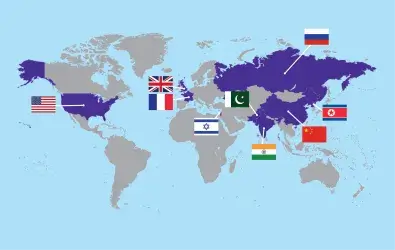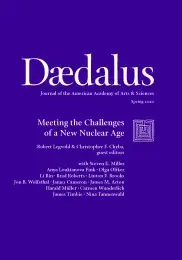
A Nuclear World Transformed: The Rise of Multilateral Disorder
The end of the Cold War produced great hope that the risks and dangers associated with nuclear weapons could be minimized or tamed in a cooperative international environment heavily regulated by arms control. If arsenals could be reduced, nuclear weapons marginalized, destabilizing factors constrained or eliminated, and proliferation prevented in a world increasingly governed by negotiated arms control, the nuclear perils of the Cold War would be left behind. Nearly three decades later, these hopes have been dashed. Instead, relations among the major nuclear powers have grown more contentious, the spread of nuclear weapons to new states has resulted in worrying regional nuclear orders, and technological advances are raising new threats and possibly introducing new instabilities, while arms control is in a state of near total collapse. A new nuclear order, combining traditional concerns with distinctive new dangers, is here. The perils of this new and still evolving nuclear reality must be understood if they are to be safely managed.
Russia’s Nuclear Weapons in a Multipolar World: Guarantors of Sovereignty, Great Power Status & More
At a time of technological and political change in the international security environment, Russia continues to view nuclear weapons as guarantors of peace and security among great powers. Nuclear weapons also assure Russia’s own great-power status and mitigate uncertainty in an emerging multipolar order. In a world where the United States pursues improved missile defense capabilities and appears to reject mutual vulnerability as a stabilizing factor, Moscow views its modernized nuclear arsenal as essential to deter Washington from a possible attack on Russia or coercive threats against it. Some elites in Russia would like to preserve existing arms control arrangements or negotiate new ones to mitigate a weakening infrastructure of strategic stability. At the same time, however, they seem skeptical that the United States is willing to compromise or deal with Russia as an equal. Meanwhile, multilateral arms control appears to be too complex a proposition for the time being.
The Revival of Nuclear Competition in an Altered Geopolitical Context: A Chinese Perspective
The U.S. government considers “power competition” to be the nature of the relations among big powers, and that it will have an impact on the evolving nuclear order in the near future. When big powers worry about power challenges from their rivals, they may use the influence of nuclear weapons to defend their own power and therefore intensify the danger of nuclear confrontation. We need to manage the nuclear relations among nuclear-weapon states and nuclear-armed states to avoid the risk of nuclear escalation. The fact is that big powers including the United States have neither the interest nor the capability to expand their power, and understanding this might cause big powers to lose their interest in power competition. If we promote dialogue among nuclear-weapon states and nuclear-armed states on their strategic objectives, it is possible to reduce the power competition that results from misperceptions and overreactions. Some other factors, for example, non-nuclear technologies and multinuclear players, could complicate the future nuclear order. We therefore need to manage these factors as well and develop international cooperation to mitigate nuclear competition.
On Adapting Nuclear Deterrence to Reduce Nuclear Risk
Since the end of the Cold War, changes to the practice of nuclear deterrence by the United States have been pursued as part of a comprehensive approach aimed at reducing nuclear risks. These changes have included steps to reduce reliance on nuclear weapons in U.S. defense and deterrence strategies. Looking to the future, the United States can do more, but only if the conditions are right. Policy-makers must avoid steps that have superficial appeal but would actually result in a net increase in nuclear risk. These include steps that make U.S. nuclear deterrence unreliable for the problems for which it remains relevant.
The End of Arms Control?
For almost half a century, the United States and the Soviet Union/Russian Federation have used arms control treaties to help regulate their nuclear relationship. The current such agreement, the 2011 New START treaty, expires in 2021, although the signatories can extend it until 2026. Because of mutual mistrust and incompatible positions on what to include in a follow-on agreement, New START will probably expire without a replacement. This essay examines the reasons for the demise of treaty-based arms control, reviews what will actually be lost by such a demise, and suggests some mitigation measures. It argues for a broader conception of arms control to include all forms of cooperative risk reduction and proposes new measures to prevent inadvertent escalation in crises.
Why Arms Control?
America survived the nuclear age through a complex combination of diplomatic and military decisions, and a good deal of luck. One of the tools that proved its value in both reducing the risks of nuclear use and setting rules for the ongoing nuclear competition were negotiated, legally binding, and verified arms control agreements. Such pacts between the United States and the Soviet Union arguably prevented the nuclear arms racing from getting worse and helped both sides climb off the Cold War nuclear precipice. Several important agreements remain in place between the United States and Russia, to the benefit of both states. Arms control is under threat, however, from domestic forces in the United States and from Russian actions that range from treaty violations to the broader weaponization of risk. But arms control can and should play a useful role in reducing the risk of nuclear war and forging a new agreement between Moscow and Washington on the new rules of the nuclear road.
What History Can Teach
Most analyses of arms control during the Cold War focus on its role in maintaining strategic stability between the United States and the Soviet Union. However, history shows that the superpowers’ search for strategic stability is insufficient to explain the roots and course of negotiations. This essay argues that arms control was used as one tool in a broader strategy of war prevention, designed to contain a series of challenges to U.S. and Soviet dominance of the international system that both sides worried could upset bipolarity and increase the chances of conflict between them. At the same time, U.S. policy-makers balanced this joint superpower interest with Washington’s extended deterrent commitment to its allies, which ultimately upheld the integrity of the system as a whole. The essay concludes that today’s leaders should integrate arms control into a more comprehensive strategy of political accommodation fit for twenty-first-century conditions.
Cyber Warfare & Inadvertent Escalation
The advent of cyber warfare exacerbates the risk of inadvertent nuclear escalation in a conventional conflict. In theory, cyber espionage and cyberattacks could enhance one state’s ability to undermine another’s nuclear deterrent. Regardless of how effective such operations might prove in practice, fear of them could generate escalatory “use-’em-before-you-lose-’em” pressures. Additionally, cyber threats could create three qualitatively new mechanisms by which a nuclear-armed state might incorrectly conclude that its nuclear deterrent was under attack. First, cyber espionage could be mistaken for a cyberattack. Second, malware could accidentally spread from systems that supported non-nuclear operations to nuclear-related systems. Third, an operation carried out by a third party could be misattributed by one state in a bilateral confrontation to its opponent. Two approaches to risk reduction are potentially viable in the short term: unilateral restraint in conducting potentially escalatory cyber operations, and bilateral or multilateral behavioral norms.
New Technologies & Strategic Stability
A variety of new technologies, ranging from broad enabling technologies to specific weapon systems, may threaten or enhance strategic stability. In this essay, I analyze a technology’s potential to significantly affect stability along three axes: the pace of advances in, and diffusion of, this technology; the technology’s implications for deterrence and defense; and the technology’s potential for direct impact on crisis decision-making. I apply this framework to examples including hypersonic weapons, antisatellite weapons, artificial intelligence, and persistent overhead monitoring. Formal arms control to contain dangers posed by some of these seems technically possible, though currently politically difficult to achieve. Others, particularly enabling technologies, resist arms control based on effective verification. The major powers will therefore instead have to find other ways to cope with these technologies and their implications. These options should include exchanges with potential adversaries so that pathways to nuclear escalation, and possible mitigating steps, can be identified and discussed.
Nuclear Disarmament without the Nuclear-Weapon States: The Nuclear Weapon Ban Treaty
The 2017 Treaty on the Prohibition of Nuclear Weapons (TPNW) represents a daring act of self-empowerment: nuclear have-nots produced an international disarmament treaty without the involvement of the nuclear-weapon states or their allies. In this essay, we assess how the new treaty relates to the existing nuclear order and its four central norms: constraints on use, political restraint, nonproliferation, and disarmament. We discuss the TPNW’s origin in and impact on this contested order. At the heart of contestation are two security concepts: deterrence versus the immediate ban of nuclear arms, which result in fundamentally different ideas on how to pursue the road to “global zero.” Whether or not the TPNW and the Treaty on the Non-Proliferation of Nuclear Weapons are compatible depends on how the opponents handle their controversies. The key is to overcome the emotionalized polarization and rediscover a common basis in order to prevent damage to the existing nuclear order and bring forward nuclear disarmament in practice.
A Way Forward
This essay develops elements of an agreement to limit and reduce nuclear forces that would succeed the New START Treaty. The successor arrangements would be more complicated than the bilateral INF, START, and New START treaties, involving more subjects and more countries, as the negotiations consider each of the issues the United States and Russia have said should be addressed in a new agreement. The result is a comprehensive program of practical steps to enhance predictability, resume the reduction of nuclear forces, and reduce the risk of conflict in an increasingly complex world.
Life beyond Arms Control: Moving toward a Global Regime of Nuclear Restraint & Responsibility
Today, we are on the verge of a world without nuclear restraint. In the absence of formal arms control, how do we proceed? What broad principles and norms would we want? What measures might nuclear-armed states take, even without formal agreement, that would reduce the risk of nuclear war and control the arms race? I suggest that nuclear-armed states move toward a global regime of nuclear restraint and responsibility. Restraint would primarily take the form of reciprocal commitments and unilateral measures to avoid an arms race and reduce nuclear dangers. Responsibility refers to the fact that nuclear-armed states must pursue limited forms of deterrence and are accountable to the international community. I suggest several steps that governments, with the help of civil society, could take, beginning with the most minimal, declaratory initiatives and unilateral measures, and proceeding to steps that require more action.
